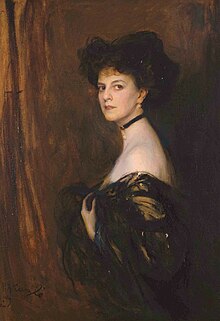Élisabeth Greffulhe
Élisabeth de Riquet de Caraman-Chimay | |
|---|---|
| Countess Greffulhe | |
 Portrait by Philip de László, 1905 | |
| Born | 11 July 1860 Paris, France |
| Died | 21 August 1952 (aged 92) Lausanne, Switzerland |
| Husband | |
| Issue | Joseph de Riquet de Caraman |
| Mother | Marie de Montesquiou-Fézensac |
Countess Marie Anatole Louise Élisabeth Greffulhe (
Life

She was born in Paris, the daughter of
The countess greatly enjoyed the company of her cousin, the exquisite aesthete Count Robert de Montesquiou, in concert with whom she was in contact with the cream of Parisian society, whom she regularly entertained at her salon in the rue d'Astorg. He would describe her eyes as "black fireflies". The colour of her eyes was unusual; as Mina Curtiss, who visited her, noticed, her eyes were like "the dark purple brown-tinged petals of a rarely seen pansy."

She married
The countess helped establish the art of
She is one of the main inspirations for the character of the duchesse de Guermantes in Marcel Proust's À la recherche du temps perdu. Her husband, Count Greffulhe, is the main and almost unique inspiration for the character of the duc de Guermantes. A recent biography demonstrates – relying in particular on research into the author's draft notebooks – that Countess Greffulhe and her family, who inspired several of the characters in À la recherche du temps perdu, played a major role in the genesis of the work and in the discovery of the "magic" name of Guermantes.[3]
She died in Lausanne, Switzerland, on 21 August 1952.
Gallery
-
Élisabeth de Caraman-Chimay, Countess Greffulhe (1860-1952) with her daughter Élaine. Photograph by Paul Nadar, 1886.
-
Élisabeth de Caraman-Chimay, Countess Greffulhe (1860-1952). Photograph by Paul Nadar, 1886.
-
Élisabeth de Caraman-Chimay, Countess Greffulhe (1860-1952). Photograph by Paul Nadar.
-
Élisabeth de Caraman-Chimay, Countess Greffulhe (1860-1952). Photograph by Paul Nadar.
-
Élisabeth de Caraman-Chimay, countess Greffulhe (1860-1952). Photograph by Otto Wegener, circa 1887.
-
Élisabeth de Caraman-Chimay, Countess Greffulhe (1860-1952). Photograph by Paul Nadar in 1895.
-
Élisabeth de Caraman-Chimay, Countess Greffulhe (1860-1952), double portrait photograph by Otto Wegener, 1899. Metropolitan Museum of Art, New York.
-
Élisabeth de Caraman-Chimay, Countess Greffulhe (1860-1952), portrait photograph by Otto Wegener, 1899.
-
Self portrait countess Elisabeth Greffulhe (1899), Carnavalet museum, 2022.
-
Élisabeth de Caraman-Chimay, Countess Greffulhe (1860-1952) and her daughter Elaine Greffulhe, photograph by Otto Wegener, 1908.
-
Countess Élisabeth Greffulhe in the Bosquet de la Colonnade in Versailles. Painting by Joseph-Raymond Fournier-Sarlovèze.
-
Henri Alexandre Gervex. An evening at Pré Catelan, 1909. Countess Greffulhe is seen ready to enter the car after her visit to the restaurant.
-
Portrait of l'abbé Mugnier. Painted by Élisabeth de Caraman-Chimay, Countess Greffulhe in 1921.
-
Portrait of elegant lady attributed to Comtesse Élisabeth Greffulhe, signed M. Leibovsky.
-
A vase commissioned by Élisabeth Greffulhe, inscribed with a quatrain by Robert de Montesquiou, her cousin.
Notes
- ^ (in French) Cossé-Brissac, Anne de, La comtesse Greffulhe, Librairie académique Perrin, Paris, 1991
- ^ Mina Curtiss, Other People's Letters, Boston: Houghton Mifflin Company, 1978.
- ^ Laure Hillerin, La comtesse Greffulhe, l'Ombre des Guermantes, Paris: Flammarion, 2014 (Part V, La chambre noire des Guermantes), pp. 345–455.
References
- Newton, Joy, 'Whistler's French Connections: Count Robert de Montesquiou and Countess Greffulhe,' Laurels, vol. 53, no. 1
- Michel-Thiriet, Philippe, The Book of Proust, London, 1989
- Munhall, Edgar, Whistler and Montesquiou. The Butterfly and the Bat, New York, 1995
- Painter, George, Marcel Proust, Chatto & Windus, London, 1959.
- Hillerin, Laure, La comtesse Greffulhe, l'Ombre des Guermantes, Paris, Flammarion, 2014
External links
 Media related to Élisabeth, comtesse Greffulhe at Wikimedia Commons
Media related to Élisabeth, comtesse Greffulhe at Wikimedia Commons















